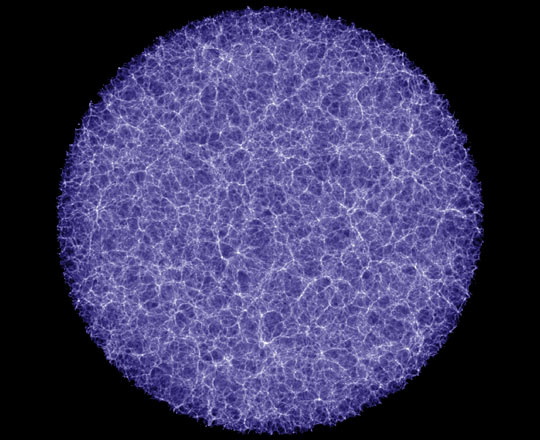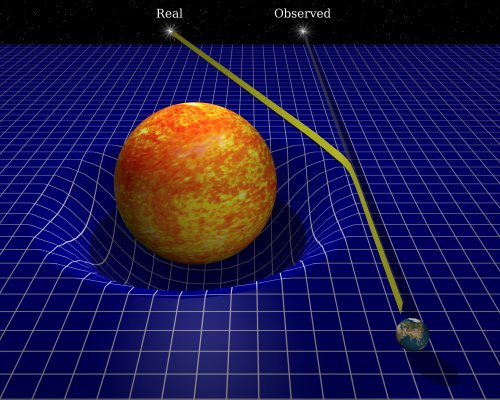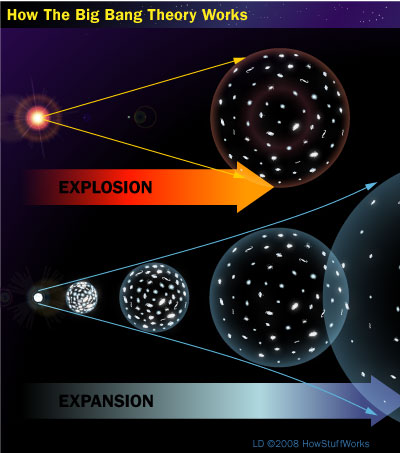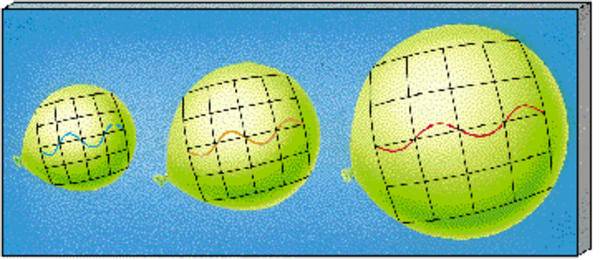"There is only one corner of the universe you can be certain of improving, and that's your own self." -Aldous Huxley
Earlier this week, I told you the story of how we went from a Universe that was -- at one time -- almost perfectly smooth, full of tiny, random fluctuations in density,

to the Universe we have today, full of stars, galaxies, and clusters of galaxies all clumped together in a beautiful cosmic web of structure.

But there was one picture I showed that generated a lot of questions. I put up an image showing what the Universe was made out of today (when we have this great cosmic web), and what the Universe was made out of back when the cosmic microwave background (the tiny, one-in-a-hundred-thousand density fluctuations) was emitted. Not surprisingly, the two pie charts look very different.

But this is one of the most beautiful things about not just astronomy, but astrophysics.
If you give me a theory of gravity and how it relates to space and time, like Einstein did nearly 100 years ago,

and an expanding Universe that's roughly smooth on large scales, then all I need to know is what's in the Universe at any one time (like say, today), and I can tell you a whole slew of things!
Like what, you ask?
- The energy density of each component of the Universe at any time,
- The expansion rate of the Universe at any time,
- The age of the Universe,
- The size of the observable Universe, and
- How important any part of the Universe is -- atoms, dark matter, dark energy -- at any given time.
The equations that relate what's in the Universe to the size, age, and expansion rate of the Universe have been well-known since the 1920s, and were the basis for Hubble's conclusion that the Universe was expanding.

But fast-forward to today, where we know how much of today's Universe is made out of dark matter, dark energy, atoms, neutrinos, and photons. For the first time in history, actually, we know these numbers accurately: to within about 1%.

So I can do the math, and make some graphs for you. The observable Universe is presently 93 billion light-years in diameter, give-or-take about 1%. But, since it's expanding, it was smaller in the past. If we go back to when it was 10%, or 1%, or 0.1% of its current size, how important were each of the five things -- dark energy, dark matter, normal matter (atoms), photons, and neutrinos -- we know our Universe is made out of?
Well, the density of dark energy -- the densest thing right now -- was the same in the past. (That's why it's sometimes called a cosmological constant.) But both normal matter and dark matter were even denser in the past! When the Universe was 10% of its present size, or 9.3 billion light years in diameter, dark matter and normal matter were the most important things in there.
But go back even farther, and you'll discover that photons, which started out today with the lowest energy density (at about 0.008%), overtake not only neutrinos and dark energy, but even normal matter and dark matter at early enough times!
Why's this?

Because when your Universe was smaller -- in the past -- the wavelength of your photons was also shorter, which means they had more energy! Anything that acts like radiation -- including neutrinos at these early stages -- loses energy at a faster rate as the Universe expands than matter of any type -- whether dark or normal -- does.
So if we put all of this together, and say that the total energy of the Universe at any time is 100%, what do we find that the Universe is made out of at any given time?

This. Today, dark energy is just starting to take over as the most important form of energy in the Universe, from dark matter. It happened, in fact, when the Universe was already about 2/3 of its current size! Before that, matter was king, with dark matter at about 83% and normal matter at around 17% of the Universe. And this was true from when the Universe was about 1% of its current size (when it was only about 10 million years old) until dark energy took over.
But when the Universe was even smaller? Radiation -- in the form of photons and (to a slightly lesser extent) neutrinos -- was not only important, but at small enough scales, dominated the Universe. Radiation dominates all the way back until inflation happened, and our Universe, as we know it, first began.
The cosmic microwave background came at an important transitional time in the Universe, when it was about 0.092% of its current size. At that time -- when the Universe was only 380,000 years old -- neutrinos, photons, normal matter, and dark matter were all energetically important components of the Universe!

And that's why the Universe looks so different -- in terms of energy -- when it was so much younger! And now you know what's in the Universe at any given time. Want to know what it'll be like farther into the future? Just extend these graphs I made, and you'll find that dark energy takes over, leading to a cold, bleak, lonely future.
How lucky are we to be here right now?



Holy. Cow.
That's a pretty nice plot showing how the fractional energy density of the universe changes over time. It will be good to finally pin down what exactly the dark matter and energy are. We have ideas but nothing for sure.
All such math involves many implicit assumptions.
Is it possible to understand our universe without understanding 95% of the elementary matter that makes up the universe. Is this an example of scientific hubris?
The humility of string theorists is refreshing by comparison. At least they admit that they don't know a lot.
The dark matter hypotheses is forced upon science as a logical conclusion of a theory of many assumptions, some key ones which may prove incorrect.
Experiments testing the various alternative theories are underway. What if they are all null? Then new theory is needed and there will be much new science.
Proclaiming success for the dark matter idea is premature. Why hype the science of dark matter as if it were a better understood science (e.g. electrons and photons)?
Dark matter theorists needs to continually emphasize what new experiments and observations are underway and necessary to disprove or prove various hypotheses.
An open mind would be helpful rather than being ready to pounce on every deviant theory. Higgs theorists are an example of being open to alternative theories.
Where did the graphs of fractional energy density vs. time come from? I'd like to see the equations.
Ambitwistor,
I made these graphs personally. The equations that they're derived from are known as the Friedmann Equations:
http://en.wikipedia.org/wiki/Friedmann_equations
OKThen,
You know my feelings on alternative theories. They have to do as well or better, across the board, than the standard theories do to have merit. Dark matter isn't "proven" -- it will take direct detection to do that -- but as I've been over many times, including as recently as Tuesday, it explains things that we observe that, so far, no alternative does.
Show me a working alternative, and I'll happily open my mind to it. But until then, I'll bet my chips on dark matter.
When was the earliest time in the history of the universe that life like ours could have evolved or (if we had a time machine) survive if introduced?
Muz: Potasyum bakımından zengindir ki bu da kan basıncını düzenliyor. İçindeki vitamin B6 ise yorgunluÄu, asabiyeti ve uykusuzluÄu engelliyor ve ruh halinizi yükselten serotonin salgılamanıza sebep oluyor.
I've worked with the Friedmann equations before to calculate the evolution of the universe's size over time, but I've never applied them to back out fractional density over time. I guess you would apply the reasoning found in the "Mixtures" section of the Wikipedia article ... giving normal matter the "pressureless dust" equation of state, photons the radiation equation of state, dark energy the cosmological constant equation of state, etc. And evolving backward in time from known modern values?
Oops, your graph isn't a function of time, it's a function of scale factor.
25 yaÅındaki futbolcu ile her konu da anlaÅan BeÅiktaÅ yönetimi, EskiÅehirspor ile aradaki pürüzleri gidermeye çalıÅıyor. Ä°lk olarak BeÅiktaÅâtan 3 milyon Euro bonservis ücreti talep eden Kırmızı Beyazlı ekip, bu miktardan aÅaÄı düÅmeyeceklerini belirtmiÅti.
Ambitwistor,
That's right, but it's difficult with neutrinos, because they act like matter today (non-relativistic), but acted like radiation when the Universe was hotter; so that's a special case.
But yes, the easiest way to do it is to evolve backwards from modern values.
Prof.Pedant,
It's conceivable that life like us could have, under the absolutely most favorable conditions, evolved when the Universe was about 4-6 billion years old, or between 1/3 and 1/2 of its present age.
But would they have been able to even detect the existence of dark energy? Possibly not!
I do love theoretical astrophyics.
So in effect your pie charts shows the universe is being eaten up by dark matter & dark energy?
I will keep reading your blog.
How did you handle the neutrinos, then?
Ambitwistor,
You need to choose a mass value for the neutrinos, and then use the standard formula for energy density of a gas of fermions dependent on its temperature. (I don't have the formula at my fingertips now, but it's available in any good cosmology textbook, like Peebles' Principles of Physical Cosmology or Peacock's Cosmological Principles.)
If you want to do it much more simply (and less accurately), scale neutrinos like matter until the Temperature (in Kelvins) times Boltzmann's constant equals the mass of your neutrino * c^2, and then treat it like radiation, where it has a temperature equal to the cubed root of (4/11) times the photon temperature.
But, as you may have noticed, this is way more technical than I normally get in a blog post. I try to keep the heavy lifting in the background, and focus on the results.
Would it be fair to compare our current certainty about dark matter to, say, atomic theory in the 1870's or so?
"It's conceivable that life like us could have, under the absolutely most favorable conditions, evolved when the Universe was about 4-6 billion years old, or between 1/3 and 1/2 of its present age."
Interesting.....
"But would they have been able to even detect the existence of dark energy? Possibly not!"
Just as there will be fewer and fewer visible galaxies as the universe continues to expand. Eventually any galaxy beyond the local group will only be known from the old records.
It occurs to me that such an implausibly early intelligence would probably have had a 'fully developed' physics for a long time before they first detect the existence of dark energy.....I wonder if they would have anticipated the discovery or if it would come as an actual surprise to them.
Elucidating as always, thank you Ethan.
While I agree we are very lucky to be here (given how inhospitable the universe is to life in general), I don't think it's luck that the time we arose happens to be while the state of the universe is most suitable for life to arise :) If we were around during inflation, then we'd have to be lucky :)
Perhaps all those intelligent beings who were around before inflation felt sorry for the saps who would come later with no way to figure out what went on :(
It's conceivable that life like us could have, under the absolutely most favorable conditions, evolved when the Universe was about 4-6 billion years old, or between 1/3 and 1/2 of its present age.
I've never really posted a comment about DE on this blog, namely because I am still not convinced that the DE/cosmological constant can not be further divided into differing components w/more stringent concrete explanations.
I see DM and DE as taking on perspective portions of the cos. con. in terms of DM as a local structure and DE as expansion of non local structure/space.
So, according to your most excellent graph, The dominant form went from total radiation to total matter, to presumably grossly disproportional DE, Hence very cold and lonely.
Just questions.
Are there boundaries to the increase of acceleration that can occur?
If so what would set such boundaries?
Why do we see an increasing acceleration now and not directly after inflation?
Are the decreases in total radiation,photons and neutrinos an artifact of a larger Universe and does this ratio effect DE acceleration?
Will we see the CMB fade from view or will we see it's temperature fall...or both?
I think I have a pretty good grasp on DM, but as far as DE...I need a few more pieces to the puzzle.
"It's conceivable that life like us could have, under the absolutely most favorable conditions, evolved when the Universe was about 4-6 billion years old, or between 1/3 and 1/2 of its present age."
An early life-form evolved rapidly mastering light speed space travel in the process. Total annihilation forced their departure when the universe is only 5 billion years old. The only place they thought they had any chance of surviving was found however calculations showed the universe would be 13.7 billion years old when they awoke from cryogenic freezing upon arrival. If they plotted their course based on physics that did not take dark energy into account would they reach their intended location, or wake up only to find something went terribly wrong and have no clue as to why. Yet another reason to be happy we live at the time we do.
I find it unnecessary to define the cosmological constant as being constant throughout our Universal history.
The specific makeup of the Universe at any given time is never exactly the same from one moment to the next...the cosmological constant is dynamic.
Surly there are more definable stages we have not yet discovered that lie between conception and today's expansion.
We have to work in stages to narrow the constant for specific times, such as inflation, yet a dynamic constant on the cosmological scale will always need to be fine tuned until all the players are known, most importantly what processes effect the *constant*
"Just extend these graphs I made, and you'll find that dark energy takes over, leading to a cold, bleak, lonely future."
So we have a "cold death" of the universe rather than a "heat death"?
Ethan
In my opinion your Nov 17, 2010 post is the only one where you explicitly state that there are many possible explanation (e.g. particles, mechanisms) for the "dark matter" observations.
I quote you:
"This stuff can be anything you can think of, and includes:
--normal matter (protons, neutrons, and electrons),
--photons (particles of light),
--neutrinos,
--dark matter (stuff that gravitationally works like matter, but doesn't interact with photons or itself),
--vacuum energy / cosmological constant,
--exotic forms of matter (cosmic strings, domain walls, etc.), and
--curvature.
This isn't an exhaustive list, but it may as well be. "
I assumed, hopefully correctly, that this was a list of the candidate explanations for the "dark matter" observations.
In contrast to cosmologists, elementary particle physicists regularlly express their openness to a range of theories.
"The truth is that most physicists would be more excited by the failure than by the success. If the Higgs boson remains undetectable at the LHC, this means that there must be physics beyond the standard model: that would be the really important discovery... the first possibility is that the decay might be primarily to other new particles not yet discovered... The other possibility is that the role of the Higgs is not played by a single particle." Wolfenstein and Silva, Exploring Elementary Particles, pg 218, copyright 2011.
This is just one of many examples of elementary particle physics "talk" which always expresses alternatives. In constrast cosmologists almost never "talk" alternative. I did appreciate your Nov 17, 2010 blog.
But the absolutist "talk" about dark matter needs to be engaged in dialogue by continually suggesting alternatives as possibilities (not as punching bags) or even just allowing that we really know very little about the hypothesized stuff labeled "dark matter". A label does not equal understanding.
Very cool graphs. I like them. It's very interesting. Could you graph them extrapolating into the future? Assuming extrapolation into the future is correct (I know, it's a big if), it would be interesting to here how you think the structure of the universe would change as a result.
The Fractional Energy Density graph is a very nice post -modern extrapolation of a little bit of knowledge into the realm of absolute ignorance.
A step into the realm of absolute ignorance is usually accompanied by a warm gooey feeling from which gradually arises a foul odor.
Türkiyeâyi Almanyaâda yapılacak Eurovision 2011 Åarkı YarıÅmasıânda Yüksek Sadakat grubu temsil edecek.
-
ANKARA (A.A) TRTâde yılbaÅı nedeniyle yayınlanan özel eÄlence programında, Türkiyeâyi 2011 yılında Almanyaâda yapılacak Eurovision Åarkı yarıÅmasında âYüksek Sadakatâgrubunun temsil edeceÄi bildirildi.
Eurovision 2010 Åarkı YarıÅmasında, Lenaânın seslendirdiÄi parçayla birinciliÄi elde eden Almanya, 56. Eurovision Åarkı YarıÅmasına ev sahipliÄi yapacak.
Increased volume equals less density? Conventional enough.
I guess a thought experiment would go like, "How much energy does it take to actually expand a vacuum?" Another one might be, "But where's that giant sucking sound actually coming from?".
Ethan Siegel said, "Show me a working alternative, and I'll happily open my mind to it. But until then, I'll bet my chips on dark matter."
With the "extragalactic catastrophe" which you and your colleagues call the "dark matter and dark energy problem" you should expect the solution to this "serious anomaly" to be simple, plausible and comprehensive and not some mind-boggling, highly-mathematical, incomprehensible idea that is daily published on the ArXiv. It does not take a genius to come up with the idea that "light is gravitationally attractive." This "alternative" is simple, plausible and comprehensive. The trouble with this alternative is that it is mundane and embarrassing to our highly-trained, esteemed scientists. The radiation pressure studies give our learned ones the excuse to dismiss the simple possibility that it is just the radiation leaving an astrophysical body and not its mass that is doing the gravitational attracting that keeps the stars, galaxies and clusters gravitationally bound. There are hints in the literature that it is the radiation that is doing the attracting. The most obvious hint is the Tully-Fisher relation which Milgrom's MOND harnesses. Then there are the terrestrial experiments: (1)The Crookes radiometer which gives an opposite effect to the Nichols radiometer (2) P.E. Shaw's initial finding that heating the large mass in Cavendish experiment will increase big G (3) Saxl's finding that the surface gravity
will increase by 5% during a solar eclipse and (4) Marice Allais' finding that there is a diurnal variation in surface gravity. Then there are my experiments which show loud and clear that "spreading infrared radiation" is gravitationally attractive. Sure go on ignoring this simple possibility that light is attractive. Keep on believing that the textbook is right, that 95% of the universe is composed of substance we no nothing about and all that money being spent looking the missing matter and energy is a sound, scientific endeavor-- well worth the expenditure of valuable resources. http://vixra.org/abs/0907.0018
#28, is PSUEDOSCIENCE; not a scientific explanation to the highly credible dark matter observations (albeit inadequately explained by current theory.)
Peter Fred
I followed your name link; your experiment is ABSOLUTELY INCORRECT!
Your abstract explains that a 489 gm copper mass increases by 47 grams in 400 seconds by using a 1000 watt heating element and two buckets of ice.
Something is seriously wrong with your experimental technique.
I wonder how you prepare classes in theoretical astrophysics, any text book has to be already out of date by the time it's printed.
@ AngelGabriel Your reaction my experiments is typical. However, there have been experimental surprises in the past that have run against the prevailing, ingrained theory such as cosmic acceleration, Rutherford's gold foil experiments, the photoelectric effect and the black body spectrum. With my experiments I could have an artifact that is giving a spurious result. Nevertheless, I have spent a considerable amount of time trying to find it. But I tire of looking for it (I have been doing these experiments 15 years) and hoping I could find someone who would want replicate my experiments as what happened with cosmic acceleration. With the "serious anomalies" mentioned above, a new theory had to be devised to explain their unexpected results. With the "extragalactic catastrophe" you have got to admit we may very well need a new theory of gravity. The old theory might not be working too well if it forces us to believe that 95% of the universe is composed of some strange entities like the dark matter and the dark energy. If radiation is proven to be attractive by experimenters other than me, we have available a radiation-based theory that could seriously challenge GR and Newton's theory and give us a more "close to experience" physics that we certainly not had have in the past as regards gravity. With the Tully-Fisher relation and Allais' finding of a diurnal variation in surface gravity, we do have independent indications that "spreading infrared radiation" might be attractive. Sandwiching the test mass between a heat source and a cold sink is critical to getting a reliable, repeatable change of weight. These condition are not normally encountered in everyday life. I forgot another independent support for my "unexpected" result. Podkletnov hovered a test mass over a vat of liquid nitrogen and observed a decrease in weight (of ~3%) as I did in one of my experiments (4.9 %). Of course, most people think that the change of weight of Podketnov's test mass was due to the rotating superconductor in the vat. http://en.wikipedia.org/wiki/Eugene_Podkletnov
Wasn't your stuff extensively "discussed" on Good Math Bad Math last year?
Ethan, here's a simple question that maybe you can address in a future blog post.
You state that the universe is ~13.7 billion years old, and that it's approximately 93 billion light-years across.
That doesn't seem to line up.
Imagine two pieces of light going in opposite directions created during the big bang. Since the universe is 13.7 billion years old, the maximum size would be 13.7x2 = 27.4 billion light-years across.
How can it be larger than "the speed of light times the age" would indicate?
-KM
KM, during inflation, the fabric of space happens "faster" than the speed of light.
Inflation is required for the size of the universe to be 0 at t=0. If size > 0 @ t=0, then obivously t > 0. :)
KM, during inflation, the expansion of the fabric of space happens "faster" than the speed of light.
Inflation is required for the size of the universe to be 0 at t=0. If size > 0 @ t=0, then obivously t > 0. :)
ÃatıÅmada ölen ya da yaralanan olup olmadıÄı henüz açıklanmezken, PKKâlıları etkisiz hale getirmek için baÅlatılan operasyon sürdürülüyor.Bu arada PKKâdan kaçan 1 terörist Eruh Ä°lçe Jandarma KomutanlıÄıâna gelerek teslim oldu. Siirtâin daÄlık arazi kesiminde güvenlik güçlerinin sürdürdüÄü faaliyet sırasında PKKâlılara ait bir maÄarada 1 tabanca, 2 KalaÅnikof Åarjörü ile çeÅitli yaÅam malzemeleri ele geçirildi.
when the universe was smaller does that meen the galaxys, stars and plants were closer togeather? so space travel in theary would have been easyer then?